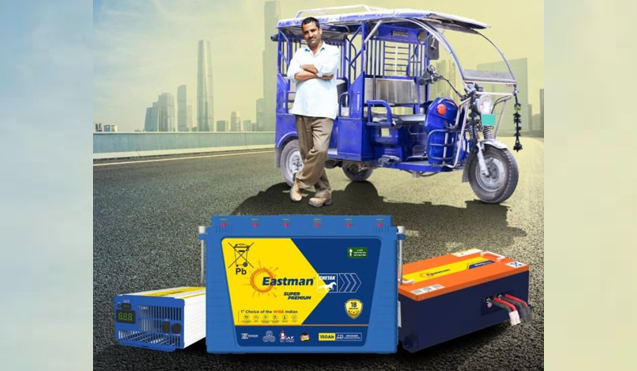Choosing the Perfect Battery for Your E-Rickshaw

E-rickshaws have become a familiar sight on the bustling streets of India since their introduction during the 2010 Commonwealth Games. These eco-friendly vehicles were designed to offer traditional rickshaw pullers a sustainable alternative, and they have gained significant traction. Over the past decade, e-rickshaws have grown at an impressive compound annual growth rate (CAGR) of 80%. Today, more than 2.4 million e-rickshaws provide affordable last-mile connectivity across India, with nearly three out of every four powered by Eastman batteries.
The Heart of an E-Rickshaw: The Battery
The battery is undeniably the backbone of an e-rickshaw, and selecting the right one is crucial for manufacturers aiming to produce high-quality vehicles. There are three main types of batteries used in e-rickshaws: lead-acid, lithium-ion, and nickel-metal hydride. Among these, lithium-ion batteries stand out due to their exceptional longevity and energy efficiency. They outperform both lead-acid and nickel-metal hydride batteries in terms of durability, power output, and overall performance.
Why Battery Capacity and Voltage Matter
When choosing a battery for your e-rickshaw, capacity and voltage are key factors to consider, as they significantly influence vehicle performance and efficiency. Higher capacity batteries store more charge, enabling e-rickshaws to operate for longer periods without frequent recharges.
While they may come at a higher initial cost, their extended service life reduces downtime and enhances productivity. Similarly, high-voltage batteries provide more power to the motor, improving overall performance. Though they may be more expensive upfront, they offer reliable service, making them a valuable investment for consistent performance.
Eastman's Lithium-ion batteries, with capacities starting from 105 Ampere Hour, can power an e-rickshaw for an entire day on a single charge, making them a preferred choice among Indian operators.
The Perks of Lithium-Ion Batteries
Eastman's lithium-ion batteries excel in both capacity and voltage compared to lead-acid batteries and offer additional advantages. Unlike lead-acid batteries, which have a charging efficacy of only 75%, Eastman's lithium-ion batteries boast nearly 100% charging efficacy, leading to long-term cost savings. They can be charged to 50% capacity in minutes, unlike the 6 to 8 hours required for lead-acid batteries. Additionally, they have a longer cycle life; while lead-acid batteries may have a cycle of just 200, Eastman's lithium-ion batteries offer higher cycles, lasting nearly five years.
Another advantage is weight. A lighter battery improves handling and acceleration. A 1-kilowatt hour lithium-ion battery may weigh as little as 10 kilograms, whereas a lead-acid equivalent can weigh up to 30 kilograms. Kilogram for kilogram, Eastman's lithium-ion batteries provide significantly more power, making them ideal for optimizing e-vehicle performance.
For e-rickshaw manufacturers and operators, the choice of battery impacts performance, efficiency, and sustainability. With superior energy density, quick charging capabilities, and lighter weight, lithium-ion batteries are the clear winner. By equipping e-rickshaws with Eastman's lithium-ion batteries, manufacturers can ensure their vehicles meet and exceed today's expectations, paving the way for a cleaner, more efficient future in urban transportation. This ensures e-rickshaws remain vital to India's journey toward sustainable mobility.